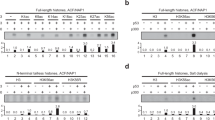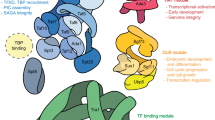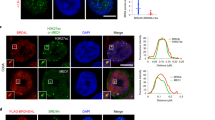Abstract
STAT transcription factors (signal transducers and activators of transcription) are cytoplasmic proteins that induce gene activation in response to cytokine receptor stimulation. Following tyrosine phosphorylation, STAT proteins translocate into the nucleus and activate specific target genes. We have previously reported that STAT3 activates the expression of the p21waf1 gene through its association with the NcoA/SRC1a and CBP coactivators. In this study, we explore the role of BRG1, a component of the SWI/SNF chromatin-remodeling complex, and the role of cdk9, a component of the elongation factor P-TEFb, in the STAT3-mediated expression of p21waf1. We found using pull-down experiments and co-immunoprecipitation assays that both proteins associate with STAT3. Chromatin immunoprecipitation (ChIP) experiments indicate that STAT3 DNA binding results in histone H3 acetylation and BRG1 recruitment. Using Southern blot analysis, we found that the loading of BRG1 is followed by an increased accessibility of the proximal p21waf1 promoter and by the association of RNA polymerase II. As a next step, STAT3 then recruits the cdk9 kinase to phosphorylate the carboxy-terminal domain of the RNA polymerase at serine 2. Accordingly, the elongating form of the polymerase can be detected by ChIP experiments on the coding region of the gene, probably initiating mRNA synthesis. Therefore, STAT3 not only promotes the initiation of transcription but also regulates chromatin remodeling and transcription elongation through its interaction with BRG1 and cdk9.
This is a preview of subscription content, access via your institution
Access options
Subscribe to this journal
Receive 50 print issues and online access
$259.00 per year
only $5.18 per issue
Buy this article
- Purchase on SpringerLink
- Instant access to full article PDF
Prices may be subject to local taxes which are calculated during checkout






Similar content being viewed by others
References
Ahn SH, Kim M and Buratowski S . (2004). Mol. Cell, 13, 67–76.
Barré B, Avril S and Coqueret O . (2003). J. Biol. Chem., 278, 2990–2996.
Bromberg J, Wrzeszczynska M, Devgan G, Zhao Y, Pestell R, Albanese C and Darnell J . (1999). Cell, 98, 295–303.
Buratowski S . (2003). Nat. Struct. Biol., 10, 679–680.
Calvo O and Manley JL . (2003). Genes Dev., 17, 1321–1327.
Cheng SW, Davies KP, Yung E, Beltran RJ, Yu J and Kalpana GV . (1999). Nat. Genet., 22, 102–105.
Cho H, Orphanides G, Sun X, Yang XJ, Ogryzko V, Lees E, Nakatani Y and Reinberg D . (1998). Mol. Cell. Biol., 18, 5355–5363.
Corey LL, Weirich CS, Benjamin IJ and Kingston RE . (2003). Genes Dev., 17, 1392–1401.
DiRenzo J, Shang Y, Phelan M, Sif S, Myers M, Kingston R and Brown M . (2000). Mol. Cell. Biol., 20, 7541–7549.
Dunaief JL, Strober BE, Guha S, Khavari PA, Alin K, Luban J, Begemann M, Crabtree GR and Goff SP . (1994). Cell, 79, 119–130.
Giraud S, Bienvenu F, Avril S, Gascan H, Heery DM and Coqueret O . (2002). J. Biol. Chem., 277, 8004–8011.
Hassan AH, Neely KE and Workman JL . (2001). Cell, 104, 817–827.
Ho CK and Shuman S . (1999). Mol. Cell., 3, 405–411.
Huang M, Qian F, Hu Y, Ang C, Li Z and Wen Z . (2002). Nat. Cell Biol., 4, 774–781.
Kingston RE and Narlikar GJ . (1999). Genes Dev., 13, 2339–2352.
Komarnitsky P, Cho EJ and Buratowski S . (2000). Genes Dev., 14, 2452–2460.
Maniatis T and Reed R . (2002). Nature, 416, 499–506.
Morillon A, Karabetsou N, O'Sullivan J, Kent N, Proudfoot N and Mellor J . (2003). Cell, 115, 425–435.
Simic R, Lindstrom DL, Tran HG, Roinick KL, Costa PJ, Johnson AD, Hartzog GA and Arndt KM . (2003). EMBO J., 22, 1846–1856.
Strahl BD and Allis CD . (2000). Nature, 403, 41–45.
Vaquero A, Loyola A and Reinberg D . (2003). Sci. Aging Knowl. Environ., 2003, RE4.
Vignali M, Hassan AH, Neely KE and Workman JL . (2000). Mol. Cell. Biol., 20, 1899–1910.
Acknowledgements
We thank Hans Clevers for the gift of expressing vectors and cell lines. This work was supported by a fellowship (to SG) from the Ministere de la Recherche et de la Technologie and by a grant from the Ligue Pour la Recherche Sur le Cancer, Comite Departemental de Maine et Loire.
Author information
Authors and Affiliations
Corresponding author
Rights and permissions
About this article
Cite this article
Giraud, S., Hurlstone, A., Avril, S. et al. Implication of BRG1 and cdk9 in the STAT3-mediated activation of the p21waf1 gene. Oncogene 23, 7391–7398 (2004). https://doi.org/10.1038/sj.onc.1207972
Received:
Revised:
Accepted:
Published:
Issue Date:
DOI: https://doi.org/10.1038/sj.onc.1207972
Keywords
This article is cited by
-
Screening of potent STAT3-SH2 domain inhibitors from JAK/STAT compound library through molecular dynamics simulation
Molecular Diversity (2023)
-
Targeting cyclin-dependent kinase 9 in cancer therapy
Acta Pharmacologica Sinica (2022)
-
Acetyl-bufalin shows potent efficacy against non-small-cell lung cancer by targeting the CDK9/STAT3 signalling pathway
British Journal of Cancer (2021)
-
CDK9 keeps RNA polymerase II on track
Cellular and Molecular Life Sciences (2021)
-
Significant lethality following liver resection in A20 heterozygous knockout mice uncovers a key role for A20 in liver regeneration
Cell Death & Differentiation (2015)



